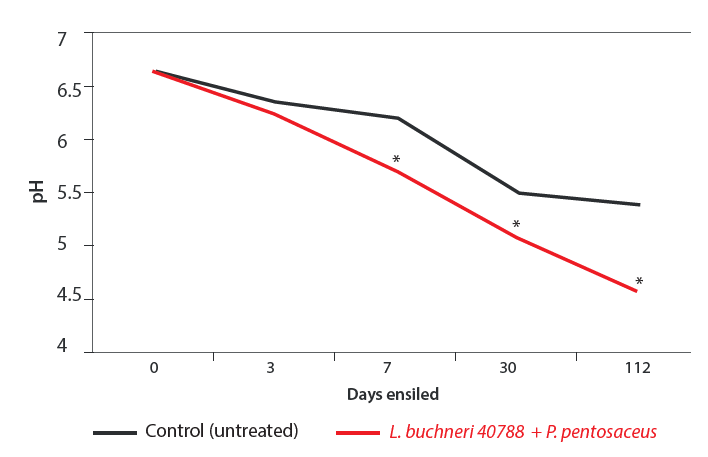Blog | Reading Time 2 minutes
Lactobacillus buchneri 40788 improves aerobic stability of sugar-rich grass
Sugar-rich grass such as bermudagrass can represent a real challenge for silage preservation. A trial by University of Florida indicates that Lactobacillus buchneri NCIMB 40788 based inoculants could be an efficient answer to improve the aerobic stability of bermudagrass silage and other sugar-rich forages.
Bermudagrass (Cynodon dactylon) represents an important source of forage in warm, tropical and sub-tropical climates. However, its low concentration of readily fermentable carbohydrates (bermuda grass is high in hemicellulose and low in fermentable sugars) makes it very susceptible to spoilage and represents a real challenge for silage preservation. Propionic acid bacteria have been applied to this type of forage to improve aerobic stability. However, the acidic conditions during first step of the ensiling process can inhibit growth and limit the ability of this type of bacteria to compete with lactic acid bacteria (LAB).
The heterofermentative bacteria Lactobacillus buchneri NCIMB 40788 is well documented to improve the aerobic stability of forages. This is what lead University of Florida scientists to test how effective L. buchneri 40788 is in improving the aerobic stability of bermudagrass (Arriola et al., 2015).
The trial
The trial was conducted on wrapped round bales of bermudagrass harvested in the second cutting of 4-week regrowth. Grass was harvested mid-morning at 8 cm with a 3-meter wide mower fitted with a conditioner and wilted for 2.5 hours.

Effect of Pediococcus pentosaceus 12455 and Lactobacillus buchneri 40788 inoculant on bermudagrass silage acidification (Arriola K.G. et al., 2015).
Improved acidification
Testing at 7 days and 30 days post ensiling showed the inoculant containing a combination of Pediococcus pentosaceus 12455 and L. buchneri 40788 had significantly reduced the pH compared to untreated bales. Thus, the inoculant was effective at fermenting sugar-rich grass at the early stages of the fermentation.
Forage analysis were conducted after 112 and 142 days of ensiling. After 112 days, lactic acid concentration was significantly improved with the inoculant as compared to untreated silage (3.2% of DM vs. 1.04 for control, p=0.008).
On the other hand, ammonia-N concentration was numerically lower (5.7 vs. 6.6% of TN), indicating reduced protein deamination and loss for the animals.
Aerobic stability improved 3-fold
The inoculant containing L. buchneri and P. pentosaceus improved the aerobic stability of bermudagrass silage by 234 hours vs. untreated silage (99 hours). Other inoculants tested, which contained only homofermentative bacteria, gave lower improvement. This trial indicates the combination of L. buchneri NCIMB 40788 and homofermentative bacteria is efficient at improving aerobic stability of bermudagrasses. This suggests also that it could be efficient to preserve other types of sugar-rich forages.
Ref: Arriola, K.G. et al. Effect of microbial inoculants on the quality and aerobic stability of Bermudagrass round-bale haylage. Journal of Dairy Science. 2015;98(1):478-485.
Published Apr 18, 2019 | Updated May 30, 2023
Related articles
Need specific information?
Talk to an expert